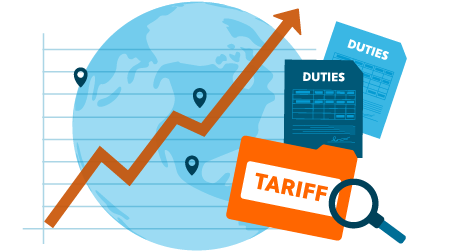
What you need to know about the US-Canada trade war
Last updated on April 7, 2025, at 12:30 ET. Attend our webinar series, Trade and Tariff Tuesdays, to hear Avalara experts discuss global trade issues and their businesses implications.
A looming U.S.-Canada trade war came into force on March 4, 2025, when the United States imposed additional tariffs on Canadian imports. Canada responded immediately with retaliatory tariffs on a host of U.S. products. And that was just the start.
Many policymakers on both sides of the border oppose the tariffs and hope they won’t last. In the meantime, Canada is taking a hard line in response to the U.S. tariffs on Canadian goods.
A lot has happened since March 4. Here’s what we know today. We’ll update this blog post as more information becomes available.
U.S. tariffs on Canadian goods
President Donald J. Trump first announced new tariffs on Canada, Mexico, and China on January 31, 2025. Since then, U.S.-Canada tariffs have been announced, delayed, implemented, paused, changed (and repeat). For affected businesses, this has a tremendous impact on compliance.
The U.S. imposed additional duty rates on “goods that are the product of Canada entered for consumption, or withdrawn from warehouse for consumption,” on or after 12:01 a.m. ET on March 4, 2025.
Per U.S. Customs and Border Protection (CBP) guidance, the new tariffs affect the following Harmonized Tariff Schedule of the United States classifications (HTSUS codes, or simply HTS codes):
- 9903.01.10: A 25% additional ad valorem rate of duty on all imports of articles that are products of Canada except:
- Products classifiable under headings 9903.01.11, 9903.01.12, and 9903.01.13
- Products for personal use in accompanied baggage of persons arriving in the U.S.
- 9903.01.13: A 10% additional ad valorem rate of duty on imports of energy or energy resources of Canada, as defined in section 8 of Executive Order 14156 as crude oil, natural gas, lease condensates, natural gas liquids, refined petroleum products, uranium, coal, biofuels, geothermal heat, the kinetic movement of flowing water, and certain critical minerals
Additional guidance is available in CSMS # 64384496, CSMS # 64384423, and CSMS # 64375535.
The March 4 tariffs applied to automobiles and auto parts as well as other products. But on March 5, President Trump paused the tariffs on automobiles from Canada and Mexico after meeting with the big three auto dealers (Stellantis, Ford, and General Motors). “There is a one-month exemption on any autos coming through USMCA,” said White House Press Secretary Karoline Leavitt, adding that reciprocal tariffs would still go into effect on April 2, 2025.
On March 6, the president paused the tariffs for Canadian products covered under the United States-Mexico-Canada Agreement (USMCA). He also lowered the additional tariff on potash from 25% to 10%. His executive order gives March 7 at 12:01 a.m. ET as the effective date of the exemption, but no expiration date. See guidance from CBP for more details.
President Trump made a similar announcement for Mexico on March 5. According to a White House official, the exemptions apply to approximately 50% of Mexican imports and 38% of Canadian imports; those numbers have been disputed.
On April 2, Trump announced what he calls reciprocal tariffs on close to 60 countries. Duty rates range from 10% to 50%. Canada is not subject to these reciprocal tariffs.
New tariffs on aluminum and steel
A 25% tariff on certain steel and aluminum imports from all countries, including Canada, took effect March 12. This also applies to certain derivative steel articles and certain derivative aluminum products. You can find more details in our blog post, Trump steel and aluminum tariffs: What you need to know.
Beer cans and empty aluminum cans were added to the list of affected products effective April 4, 2025, at 12:01 a.m. ET.
New tariffs on automobiles
On March 26, President Trump announced a 25% tariff on automobiles and certain auto parts not made in the U.S.
The 25% tariff on imported passenger vehicles and light trucks came into effect at 12:01 a.m. ET on April 3, 2025.
The 25% tariff on “key automobile parts” (engines, transmissions, power train parts, and electrical components) takes effect “on the date specified in the Federal Register for automobile parts, but no later than May 3, 2025.” Another document from the Federal Register gives the effective date as 12:01 a.m. ET on May 3, 2025.
What is a “product of Canada”?
A “product of Canada” means at least 98% of the total direct costs of producing or manufacturing the item were incurred in Canada, and “the last substantial transformation of the good occurred in Canada,” according to the Government of Canada.
“Made in Canada” means between 51% and 98% of the total direct costs occurred in Canada, and the last substantial transformation of the good occurred in Canada. The “Made in Canada” label should be accompanied by an appropriate qualifying statement, such as “Made in Canada with imported parts.”
What are Canada’s retaliatory tariffs?
Responding to Trump’s first wave of tariffs, Canada imposed 25% tariffs on $30 billion CAD in goods as of 12:01 a.m. ET, March 4, 2025.
Canada’s March 4 tariffs apply to goods imported for commercial and personal purposes, even when exported from a country other than the U.S. In other words, affected goods originating in the U.S. are subject to the tariff even if shipped from another country.
Proof of origin must be submitted for all imported goods, barring certain exceptions.
For this first wave of tariffs, affected products include apparel and footwear, appliances, beer, coffee, cosmetics, orange juice, peanut butter, motorcycles, spirits, wine, and certain pulp and paper products.
The additional 25% tariff does not apply to goods classified under Chapter 98 of the Schedule to the Customs Tariff, except tariff items 9804.30, 98.25, 98.26, 9897.00.00, 9898.00.00 and 9899.00.00.
According to the Government of Canada, the additional 25% tariffs will remain in place until the U.S. eliminates its tariffs on sales of Canadian goods. The Canadian government did not pause the retaliatory tariffs on March 6, upon learning President Trump was pausing many of the tariffs on Canada.
Canadian tariffs on U.S. steel and aluminum products
Responding to the U.S. tariffs on steel and aluminum, Canada implemented 25% reciprocal tariffs starting March 13, 2025.
Per the Government of Canada, affected products include:
- $12.6 billion CAD in steel products
- $3 billion CAD in aluminum products
- $14.2 billion CAD in additional imported U.S. goods (including tools, computers and servers, display monitors, sport equipment, and cast-iron products)
Canadian tariffs on U.S. automobiles
On April 3, Canada responded to Trump’s auto tariffs with:
- A 25% tariff on all vehicles imported from the U.S. that are not compliant with the USMCA (or CUSMA, as it’s known in Canada)
- A 25% tariff on non-Canadian and non-Mexican content of USMCA compliant vehicles imported into Canada from the U.S.
Canada’s working on a plan to incentivize production and investment in Canada as well.
How Canadian provinces are responding to U.S. tariffs
Canadian provinces are responding with force. Provincial measures against the U.S. trade policies include canceling contracts with U.S. businesses, pulling U.S. products from shelves, raising tolls on U.S. vehicles, and even new export taxes.
U.S. products have been pulled from shelves in Alberta, Manitoba, New Brunswick, Newfoundland and Labrador, Nova Scotia, Ontario, Quebec, and Prince Edward Island. This hits more than 3,600 American-made alcohol products hard.
British Columbia is targeting red-state liquor products, specifically, which will result in a $40 million a year loss for manufacturers in those states, according to the B.C. government.
B.C. is “prepared to take additional action,” on top of removing liquor from red states, “if needed.” On March 6, Premier David Eby said B.C. may impose tolls on U.S. truck traffic traveling from the continental United States to Alaska.
Alberta Premier Danielle Smith called the Trump tariffs “an unjustifiable economic attack on Canadians and Albertans” as well as “a clear breach of the trade agreement signed by this same U.S. President during his first term.”
On March 5, she said Alberta fully supports Canada’s federal response, and will no longer purchase American alcohol or video lottery terminals. But Alberta won’t reduce exports of oil and gas or impose new export taxes on those products.
In Manitoba, businesses adversely affected by the tariffs will be able to defer payments of the provincial sales tax and the health and post-secondary education tax. Premier Wabanakwut Kinew is also considering cutting exports of hydroelectricity and preventing U.S. companies from bidding on Manitoba government contracts.
New Brunswick will sign no new contracts with American companies and is seeking new markets for items traditionally exported to the U.S., such as lumber and seafood. On March 4, Premier Susan Holt told CTV News her province has been preparing for Trump’s tariffs for months. “The president might not realize that we supply American defense with jet fuel,” she said. “If you go to the base in Maine ... those planes don’t get in the air without Canadian jet fuel.”
The Government of Newfoundland and Labrador is looking for new markets for local businesses and encouraging residents to avoid purchasing American products.
Nova Scotia has doubled tolls for U.S. commercial vehicles at the Cobequid Pass and limited provincial procurement for American businesses (they can no longer bid on provincial businesses). It may cancel existing contracts.
Doug Ford, the Premier of Ontario, isn’t pulling any punches. He told reporters he’ll “do everything — including cut off their energy with a smile on my face,” in response to the U.S. tariffs. “They rely on our energy; they need to feel the pain. They want to come at us hard, we’re going to come back twice as hard.”
On the evening of March 6, Ford said Ontario would impose provincial tariffs on electricity delivered to Michigan, Minnesota, and New York, which are the three biggest customers for Ontario power. The 25% surcharge took effect March 10 but was suspended the following day and is no longer in play.
Prince Edward Island is reviewing all American government contracts.
Quebec announced a 25% penalty for American firms bidding on Quebec government contracts. Like Ontario Premier Doug Ford, Premier François Legault considered shutting down power exports to the U.S.
In a Facebook statement, Saskatchewan Premier Scott Moe said, “Canada’s response needs to be economically sound and reasoned,” and that his cabinet would “consider all options.” On March 6, Saskatchewan said it would stop purchasing U.S.-produced alcohol and would reduce purchases of other U.S. purchases and contracts.
Finally, fewer Canadians are traveling to the U.S. As of mid-March, Air Canada bookings between Canada and the U.S. for April through September were down 10% year over year. And 45% of the one in five Quebecers that had planned to travel to the U.S. in 2025 have canceled or are reconsidering those trips.
Are the tariffs stackable?
Yes. One product may be subject to multiple tariffs, including a standard rate of duty, an additional duty, and a punitive duty.
Under the substantial transformation test, a product imported from Canada could be subject to a 25% Canada tariff as well as China tariffs and/or another tariff.
USMCA and the new tariffs
Many products traded between the U.S., Canada, and Mexico have been free from tariffs under the United States-Mexico-Canada Agreement (USMCA), or subject to a low rate of duty. President Trump spearheaded USMCA during his first term in office after ending the North American Free Trade Agreement (NAFTA).
“The USMCA is the largest, most significant, modern, and balanced trade agreement in history,” Trump said when signing the USMCA in January 2020. “All of our countries will benefit greatly.”
Congress isn’t scheduled to conduct a formal review of the USMCA until July 2026. According to a document published by the Congressional Research Service in December 2024, a key point will be to determine whether to extend the pact.
Goods that previously qualified for a reduction of normally applicable import duties under USMCA were subject to additional tariffs from 12:01 a.m. ET on March 4, through 12:01 a.m. ET on March 7, when the tariffs were paused. Tariffs paid during that brief window won’t be refunded.
Guidance published by the Canadian Government notes that Canada’s Duties Relief Program and Drawback Program are available for surtax paid or payable, subject to the provisions of the Canada-United States-Mexico Agreement (CUSMA).
How businesses can ease the compliance burden
Given the late-breaking nature of the recent tariff changes, automation is key to compliance.
Avalara Cross-Border automates tariff code classification and delivers real-time calculation of customs duties and import taxes for our customers. We keep our finger on the pulse of tariff policy changes and update our systems to keep businesses compliant.
“Our talented team of content researchers and content engineers work around the clock to ensure the vast array of trade content we deliver to our customers is both timely and accurate,” says Craig Reed, GM of Cross-Border at Avalara. “Despite the dizzying pace of change this past month, our team has been on top of it. Whether it’s restrictions content, tariffs, classification codes, or other trade content, we provide our customers with the tools and services they need to be in compliance, all powered by our powerful AI and automation engines.”
Contact us today to learn how we can help you stay ahead of tariff changes.
For more information about the changing tariff landscape, check out:
- How to prepare for Trump tariffs
- How to handle US-China tariffs and the eventual end of de minimis
- De minimis exemption changes are coming: Is your business ready?
- Trump steel and aluminum tariffs: What you need to know
This post was originally published on March 5, 2025.

Trade and Tariff Tuesdays
Every Tuesday Avalara experts share insights on trade tax and tariff compliance
Stay up to date
Sign up for our free newsletter and stay up to date with the latest tax news.












